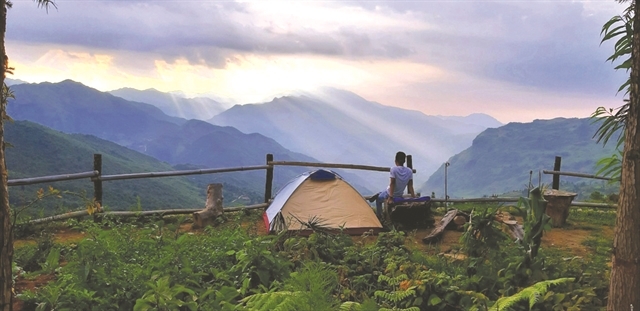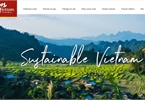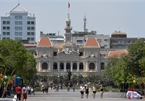It didn’t say how much was released, which is bad given the Red River Delta is prone to flash flooding from tropical storms, like the recent Higos, which killed seven people, injured four, destroyed 1,000 houses, and damaged more than 1,600ha of crops.

The setting of the sun in Y Tý Commune. VNS Photos by Cao Hương
Bat Xat, the westernmost district in Lao Cai Province, is where the Red River starts. Damage has been moderate, though, as the river cuts through remote mountains with isolated communities.
This part of Bat Xat has long been on must-see lists for the northwest, boasting magnificent mountains, clean air, and colourful ethnic minorities. By two or four wheels, distant mountains, misty jungle, and oddly-shaped white clouds count among the jaw-dropping scenery.
Now is harvest time, and tourists and photographers descend upon the mountains to admire and capture the local beauty, try some “new” rice, and breathe in fresh air and rice aroma.
But Bat Xat is beautiful all year round.
In spring, wild peach and plum flowers in bloom make for a beautiful panorama of mountain slopes blanketed in pink and white. The blanket changes to green in summer, of rice plants in terraced fields.
Autumn, which is now, is harvest time, when the ground becomes bare, while winter cold is subdued by heat from wood fires and local maize liquor.
Climb high
Two mountains around Bat Xat can be found on the list of Vietnam’s ten highest peaks: Nhìu Co San and, higher still, Ky Quan San, in the top five.
Nhiu Co San means buffalo horns in the Ha Nhi language. In Sang Ma Sao Commune and 2,965 metres above sea level, Nhìu Co San is largely untouched, with primeval jungle and challenging terrain catching the eye of trekkers and climbers alike.
Ky Quan San, meanwhile, runs along the border between Bat Xat and Phong Tho District, and climbers have put Bach Moc Luong Tu height at 3,046m above sea level in the mountain range.
According to amateur climbing clubs, climbers first reached this peak only recently, in 2013. There are two ways up — from Sang Ma Sao Commune, which is as far as a vehicle can take you, or from Chi Sang Commune in neighbouring Lai Chau Province, which is difficult to reach by any means of transport. It’s most definitely only for experienced climbers.
When a cable car made Mt Phan Xi Pang (Fansipan), Vietnam’s highest peak at 3143m, accessible to nearly everyone in 2016, many climbers began to seek other challenges, especially mountains that had yet to be conquered. And while the Bach Moc Luong Tu peak is a particularly challenging place to trek, it’s also among the most rewarding because of its spectacular scenery.
Another new trekking path has opened up in recent years, called the Pavi ancient stone path — a branch of an ancient tea route that connected tea producing regions in Vietnam, China, Laos, Thailand, Myanmar, and India.
If you’re up to it, try the 200-km trekking loop from Ban Vuoc to Muong Hum, Den Sang, and Y Ty, turn around at Ngai Thau, then A Lu, A Mu Sung, and Trinh Tuong communes. You won’t be disappointed. Starting from Ban Vuoc Commune, the route cuts through tea plantations and passes by ethnic Dao women carrying the morning tea harvest on their backs.
You’ll also pass through traditional villages of the ethnic Dao Do and Giay, where you can admire the wooden architecture of their houses and their traditional folk songs, silversmithing craft in Seo Po Ho hamlet, and famed alcohol distilled from rice buds, called San Lung.
You’re certain to come across a few charming yet chilly streams and springs along the way, and be ready to pass under waterfalls with names like Red, Dragon and Bee.
You then leave Den Sang for Y Ty, where you can explore the life and culture of the Ha Nhi.
Just where the loop starts to close is a newly discovered cave, in A Lù Commune. Reaching the 100-metre-long cave involves passing through a hundred-year-old bamboo forest in Khoa San Chải hamlet, about 1,200m above sea level. Arriving afterwards in A Mú Sung Commune, visitors greet the Lũng Pô flagpole, the point where the Red River begins in Vietnam’s territory.
Ethnic life and colours
Adding to the beautiful natural landscapes of Bat Xat, the people who call the land home make local life and culture a voyage of discovery. The Ha Nhi, Gisy, Dao, and Mong live next to each other but maintain their own traditions and customs. The Giáy honour their terraced rice field rituals, the Ha Nhi worship their jungles, the Dao preserve their sacred fire dancing myths, and the Mông perform their traditional pan-pipe dance — the pride of any Mông man.
If you venture up anywhere in the mountains, try not to miss a market fair, where local life is on display amid vibrant colours and get-togethers. This is where local farm and forest produce is brought on the back of horses or of people.
Local people also open their doors to visitors, in community tourism programmes where tourists get to live the life of real mountain people.
Authorities at all levels have invested in upgrading the road network and assisted in designing, packaging and marketing local products. Sustainability reigns above all for local governments, businesses and tour operators.
Recommended treks:
1. Sa Pa - Ban Xeo - Muong Hum - Sang Ma Sao - Den Sang - Y Ty - A Mu Sung - Lao Cai, and return.
2. Lao Cai - Bat Xat - Muong Vi - Ban Xeo - Muong Hum - Ban Khoang - Ta Giang Phing - Sa Pa, and return.
3. Sa Pa - Ban Xeo - Muong Hum - Y Ty - A Lu - A Mu Sung - Trinh Tuong - Lao Cai, and return.
4. Sa Pa - Ban Xèo - Muong Hum - Khu Chu Phin - Phong Tho - Lai Chau, and return.
VNS

Vietnam tourism launches sustainable travel showcase online
Foreign travellers dreaming of their next vacation in Vietnam can now find the country’s best sustainable tourism options in one online destination.
